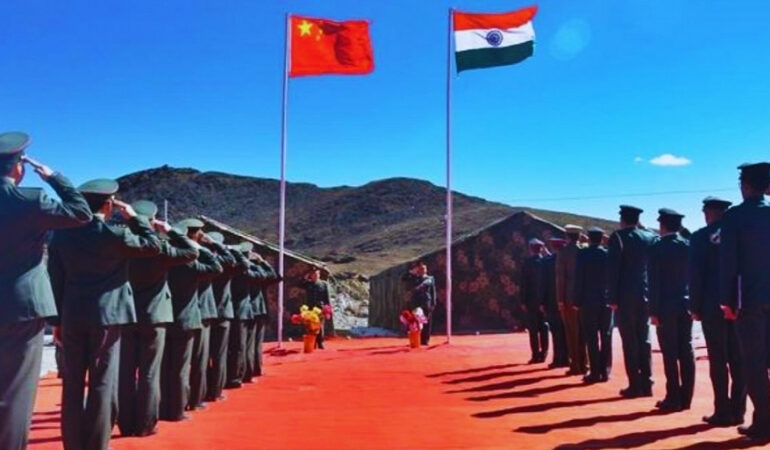India-China Border Tensions: A Diplomatic and Military Standoff

The India-China border tensions have been a recurring issue since the 1962 Sino-Indian war. The recent flare-ups, especially since the 2020 Galwan Valley clash, have brought renewed attention to the Line of Actual Control (LAC). These incidents highlight the fragile nature of India-China relations, with both nations vying for strategic dominance in the Himalayas. The dispute has global ramifications, affecting geopolitics, military postures, and trade.
Historical Context of the India-China Border Dispute
The root of the India-China border issue lies in competing territorial claims, particularly in the regions of Aksai Chin and Arunachal Pradesh. After India’s independence in 1947, the British-drawn boundaries left several areas undefined, contributing to the Sino-Indian war in 1962. China claims Aksai Chin in the west, which India considers part of its territory, while India controls Arunachal Pradesh in the east, which China refers to as South Tibet. This mismatch in territorial understanding has led to frequent military confrontations, with the LAC acting as the de facto border, but without mutual agreement on its exact location.
The conflict first became militarized in the 1950s when China built a road through Aksai Chin to connect Tibet with Xinjiang. India protested, but China solidified its control over the area after the 1962 war. Diplomatic talks, initiated to resolve the conflict, have consistently stalled, leaving the border unresolved. Over the decades, small skirmishes have occurred intermittently, with both countries accusing each other of incursions.
Recent Escalations
In recent years, tensions have escalated to levels not seen in decades. The 2020 Galwan Valley clash marked the first deadly confrontation between Indian and Chinese troops in over 40 years, resulting in the deaths of 20 Indian soldiers and an undisclosed number of Chinese casualties. This incident, which occurred in the western sector of the LAC, was preceded by a series of standoffs at multiple points along the border.
The conflict continued into 2021, with confrontations at places like Pangong Lake, where both sides accused each other of crossing into disputed territory. China’s strategic infrastructure projects, including road and airstrip construction near the LAC, have further exacerbated tensions. India has responded by increasing its own infrastructure projects in the border regions, deploying additional troops, and upgrading military assets.
Despite several rounds of high-level talks between military commanders, no significant progress has been made in resolving the disputes. Both nations have agreed to disengage in certain areas, but the presence of troops remains heavy, with the potential for further conflict looming large.
Diplomatic Efforts and Stalemate
Diplomatic negotiations have been ongoing, with numerous rounds of talks between India and China at the military and diplomatic levels. The Special Representatives’ meetings, initiated in the early 2000s, aimed at finding a long-term solution to the border issue. However, progress has been slow, with both sides holding firm to their claims.
Since the Galwan Valley clash, both countries have engaged in a series of high-level military talks, often accompanied by diplomatic back-and-forths. Despite these efforts, the situation remains tense, with no clear breakthrough in sight. The disengagement agreements reached after multiple talks have reduced the immediate threat of further clashes, but the strategic distrust between the two nations persists.
A significant factor in the stalemate is the broader geopolitical rivalry between India and China. China’s growing assertiveness in the region, including its Belt and Road Initiative (BRI), has made India wary of its intentions. Additionally, India’s closer ties with the United States and other Quad members (Japan, Australia, and the U.S.) have further complicated the dynamics between the two neighbors.
China’s Strategic Interests
China’s interest in the disputed territories stems from both strategic and geopolitical considerations. Aksai Chin, for instance, is crucial for China’s connectivity between Tibet and Xinjiang. The region’s infrastructure development, including roads and military installations, allows China to maintain a strategic advantage over India in the Himalayan region.
Additionally, China’s aggressive stance on the LAC is part of its broader geopolitical strategy in South Asia. By keeping India engaged on the border, China can divert its attention from other strategic concerns, including its growing influence in the Indian Ocean. Moreover, the standoff serves to project China’s military power, both to its domestic audience and to its rivals on the global stage.
China’s Belt and Road Initiative also plays a role in its border strategy. The initiative, which aims to connect Asia with Europe and Africa through infrastructure investments, includes projects in Pakistan and Nepal—two countries that are key to China’s regional influence. By asserting control over the LAC, China aims to safeguard its economic and strategic interests in South Asia.
India’s Response and Strategic Shifts
India, in response to China’s assertiveness, has shifted its strategic focus to strengthen its defense capabilities along the LAC. The Indian government has initiated infrastructure projects, including roads, airbases, and advanced military outposts, to match China’s developments on the other side of the border. This infrastructure is critical to India’s ability to mobilize troops and supplies in the remote, high-altitude regions where the standoffs are taking place.
In addition to infrastructure development, India has also reoriented its military strategy. The Indian Army has enhanced its deployment of special forces and high-altitude warfare units, while also upgrading its logistics capabilities. The Indian Air Force has also increased its presence in the region, deploying fighter jets and helicopters to support ground operations. India’s emphasis on technological upgrades, including the acquisition of Rafale jets from France and advanced missile systems, is part of this broader strategic shift.
India has also forged stronger defense ties with the United States, Japan, and Australia under the Quad framework. This partnership is seen as a counterbalance to China’s growing influence in the Indo-Pacific region. India’s participation in joint military exercises with these countries is part of a broader effort to enhance its defense posture and project power in the region.
Impact on Bilateral Trade and Economic Relations
The border standoff has had significant implications for India-China economic relations. Following the Galwan clash, India took a series of economic measures aimed at reducing its dependence on Chinese imports. The Indian government banned over 200 Chinese apps, including popular platforms like TikTok and WeChat, citing concerns over data security and national sovereignty.
In addition to the app bans, India has also increased scrutiny of Chinese investments in Indian companies. Several infrastructure projects involving Chinese firms have been put on hold, and India has encouraged domestic industries to reduce their reliance on Chinese suppliers. The “Atmanirbhar Bharat” (self-reliant India) initiative is part of a broader strategy to boost domestic manufacturing and reduce trade deficits with China.
Despite these efforts, China remains one of India’s largest trading partners. Bilateral trade between the two countries reached new heights in recent years, underscoring the complexity of their economic relationship. While the standoff has strained diplomatic relations, both countries have so far avoided a full-scale economic decoupling.
International Reactions
The India-China border tensions have garnered significant attention from the international community. The United States has been a vocal supporter of India, with several high-ranking officials condemning China’s actions and calling for a peaceful resolution. India’s participation in the Quad has also bolstered its standing in the Indo-Pacific region, with Japan and Australia supporting India’s stance on the LAC.
Russia, traditionally a close partner of both India and China, has called for de-escalation and peaceful dialogue between the two nations. Moscow’s role as a mediator has been limited, given its close ties with both countries, but it remains a critical player in the broader geopolitical context.
The European Union and other global powers have also expressed concern over the border tensions, with calls for both India and China to resolve the issue through dialogue and diplomacy.
The Way Forward: Possibilities and Challenges
The path forward for India and China remains uncertain. While both nations have shown a willingness to engage in dialogue, the deep-rooted mistrust between them poses a significant challenge. The border standoff is unlikely to be resolved in the near future, as both sides continue to bolster their military presence along the LAC.
One possible scenario is a continued stalemate, with intermittent skirmishes but no major escalation. In this case, both countries would likely maintain their current positions, focusing on enhancing their defense capabilities and diplomatic efforts. Another scenario involves further escalation, potentially leading to a more significant conflict. While both countries have so far avoided full-scale war, the risk remains high given the volatile nature of the border region.
The long-term solution to the India-China border dispute will require a combination of diplomatic engagement, confidence-building measures, and perhaps third-party mediation. Both countries stand to gain from a peaceful resolution, as prolonged conflict would have significant economic and geopolitical consequences for the entire region.
Conclusion
The India-China border tensions are a complex and multifaceted issue, with deep historical roots and far-reaching implications. As two of the world’s largest economies and military powers, the stakes are high for both nations. A peaceful resolution to the border dispute is essential for regional stability, but achieving it will require sustained diplomatic efforts and a willingness to compromise. In the meantime, the world will continue to watch as India and China navigate this challenging chapter in their relationship.








